The Economics and Statistics Division maintains archives of previous publications for accountability purposes, but makes no updates to keep these documents current with the latest data revisions from Statistics Canada. As a result, information in older documents may not be accurate. Please exercise caution when referring to older documents. For the latest information and historical data, please contact the individual listed to the right.
<--- Return to Archive
For additional information relating to this article, please contact:
March 26, 2025QUEBEC BUDGET 2025-26 The Province of Québec released its provincial budget for 2025-26 on March 25, 2025. Québec budgets include payments to its Generations Fund, as well as contingencies and gaps to be bridged in order to meet targets.
Québec expects that the 2025-26 deficit will be $13.61 billion, after a $2.18 billion contribution to the Generations Fund. In 2026-27, the deficit is projected to contract to $9.53 billion, after another $2.40 billion contribution to the Generations Fund. In 2025-26 and 2026-27, the Québec Budget provides a $2 billion contingency amount for each fiscal year. The contingency declines to $1.5 billion in each of the subsequent three fiscal years.
In the medium term, the Québec Budget acknowledges that there is a fiscal gap that must be closed to meet fiscal targets (including the contribution to the Generations Fund): $1 billion in 2027-28 and $2.5 billion in each of 2028-29 and 2029-30.
In 2025-26, Québec's revenues are projected to increase by 0.7% while expenditures rise by 1.5%. Revenue growth for 2026-27 is projected to accelerate to 5.7% while expenditure growth is only expected to speed up to 2.7%. Over the subsequent three fiscal years, revenue growth is projected to outpace expenditure growth and ultimately bring Québec's budget back to a small surplus by 2029-30.
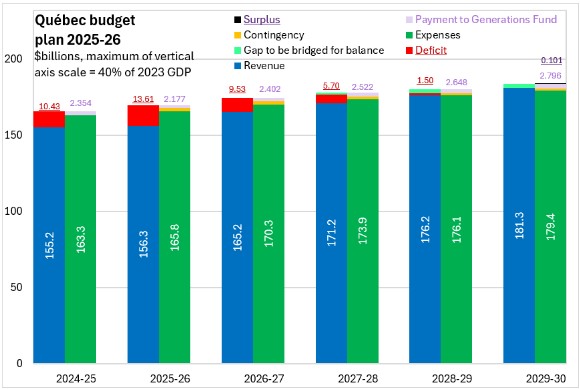
Measured as a share of GDP, the footprint of provincial government in Québec's economy amounts to 27.0% of GDP in 2025-26. This is projected to shrink to 25.4% of GDP by 2029-30.
Québec's 2025-26 deficit (after payment to the Generations Fund) amounts to 2.2% of provincial GDP estimated for 2025. In 2026-27, the deficit is projected to contract to 1.5% of GDP.
Québec's net debt is projected to rise to 40.4% of GDP for fiscal year 2025-26. This ratio is projected to rise to 41.9% of GDP by 2027-28 before falling to 39.8% of GDP in 2029-30.
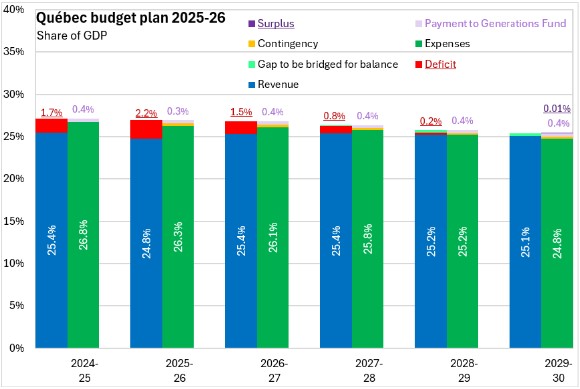
Québec's 2025-26 Budget expenditures amount to $18,215 per capita plus a revenue contingency of $220 per capita and a $239 per capita contribution to the Generations Fund. This is funded by revenues of $17,179 per capita and a deficit of $1,495 per capita. Expenditures per capita are projected to rise by $1,289 by 2029-30 while per capita revenues rise $2,531.

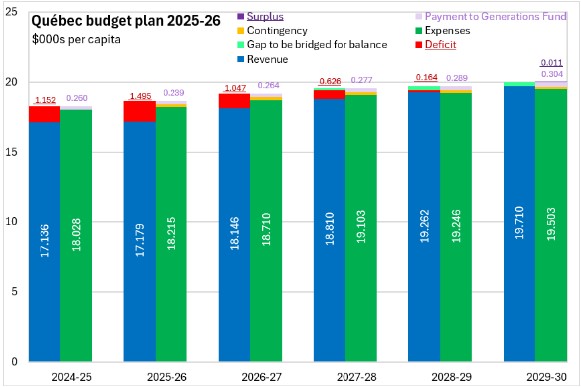
Québec's outlook for expenditures is higher than the forecast from the 2024-25 Budget while revenue growth is projected to be similar to the plan outlined last year (though less volatile).
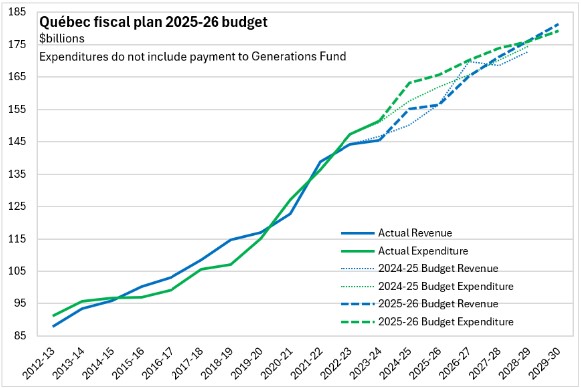
Québec's outlook for deficits is lower compared with the outlook presented in the 2024-25 fiscal plan.
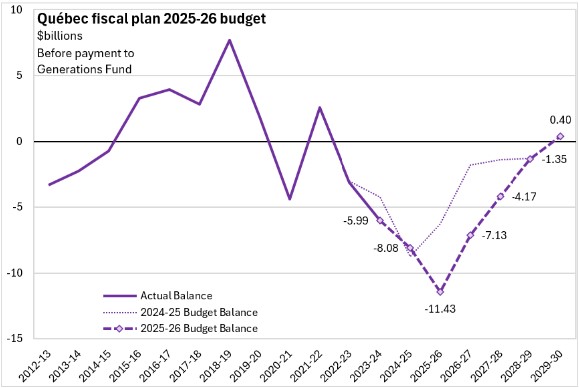

Québec's economic outlook anticipates real GDP growth of 1.1% in 2025 and 1.4% in 2026 with modest US tariffs amounting to 10% for 2 years. This tariff assumption results in economic growth that is constrained by weak exports and limited population growth as well as diminished confidence weighing on household consumption and business investment. Consumption and investment spending are expected to receive some offsetting support from lower interest rates.
With considerable uncertainty due to US tariffs, the 2025-26 Québec Budget presents two alternate economic growth scenarios, one in which 2 years of 25% tariffs from the US result in a 0.1% contraction of real GDP in 2025 followed by weak recovery of 0.5% in 2026. This scenario increase Québec's 2025-26 deficit by $1.2 billion. Under a more positive alternate scenario, recovering international trade boosts Québec's real GDP growth to 1.8% in 2025 (improving Québec's 2025-26 deficit by $900 million) and 2.0% in 2026.
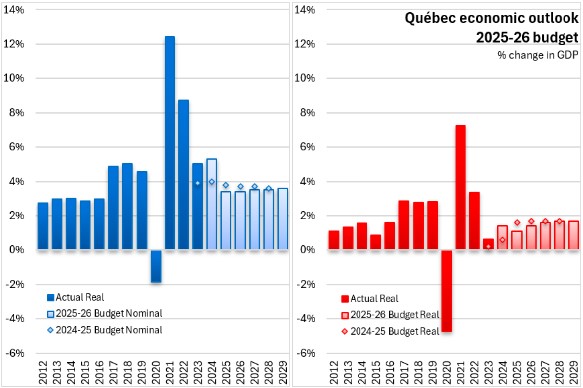
Key Measures and Initiatives
Québec's 2025-26 Budget focuses its efforts on stimulating wealth creation and supporting Quebecers. Key measures include:
Simulating wealth creation with measures of $5.4 billion over 5 years
- $1.6 billion for loans affected by US tariffs
- $4.1 billion for transitional assistance to businesses affected by US tariffs as well as for market diversification and investment projects
- $604.1 million for tax assistance to support innovation/commercialization, modernizing public service and helping SMBs/key sectors
- $759.0 million in supports for critical minerals, forestry, tourism and bio-food sectors.
Supporting Quebecers with $6.8 billion in initiatives over 6 years
- $3.9 billion for improving health and social services
- $1.1 billion for educational improvements and participation in sport/recreation
- $550 million for enhanced pensions for injured workers as well as targeted support for disadvantaged individuals
- $717 million for showcasing Québec's culture and identity and supporting quality services for immigrants
- $635 million for safe communities and climate change
Tax measures amounting to $3.0 billion in added revenues over 5 years, resulting from a review of 277 tax expenditures
- $604 million for targeting IT sector supports on higher value added artificial intelligence activities as well as refocusing tax credits for critical minerals
- $1.14 billion from harmonizing Québec Sales Tax and the rate of tax on insurance premiums and flow-through share regime with the Federal government
- $482 million from reducing the age limit for childcare expense credits from 16 to 14, excluding certain practitioners from eligible expenses for medical tax credits, ending recognition of certain institutions for tuition and examination tax credits, reducing cooperatives investment plan deduction amounts, restoring balance between property tax and public utilities taxes
- $98 million in revenue reductions from raising the threshold above which additional registration fees apply to luxury vehicles
- Ending little-used tax measures: deduction for income-averaging annuity for artists, tax holiday for Québec sailors, tax credit for cultural patronage, tax holiday for foreign specialists in international finance, deductions for transit passes, tax credits to foster synergy between Québec businesses, refund of the biodiesel fuel tax
- $748 million for ending indexation of threshold for reduced employer contributions to the Health Services Fund, ending free access for electric vehicles to toll bridges/ferries while adding annual fees to electric vehicle/PHEV registrations to support the road network, increasing the land register consultation fee
Québec Budget 2025-26
<--- Return to Archive